My Background
<canvas> entered my awareness in 2006 when Firefox v2.0 was released. An article on Ajaxian, describing the transformation matrix, inspired me to create my first <canvas> web-app; Color Sphere (2007). Which immersed me into the world of colors, and graphic primitives; inspiring the creation of Sketchpad (2007-2008) in an effort to put together an application "better than Paint" in the browser.
These experiments eventually led to the creation of the startup Mugtug with
my long-time friend Charles Pritchard. We're developing Darkroom in HTML5 <canvas>. Darkroom
is a non-destructive photo-sharing app, combining the powers of pixel-based filters with
vector-based typography and drawing.
Introduction

<canvas> brings Javascript programmers full-control of the colors,
vectors and pixels on their screens - the visual makeup of the monitor.
The following examples deal with one area in <canvas> that hasnt gotten
much attention; creating text-effects. The variety of text-effects
that can be created in <canvas> are as vast as you can imagine - these demos
cover a sub-section of what is possible. Although we 're dealing with
"text" in this article, the methods can be applied to any vector objects;
creating exciting visuals in games, and other applications:
- Text-Shadows in
<canvas>. - CSS-like text-effects in
<canvas>creating clipping masks, finding metrics in<canvas>, and using the shadow property. - Neon-rainbow, zebra-reflection - chaining effects.
- Photoshop-like text-effects in
<canvas>examples of using globalCompositeOperation, createLinearGradient, createPattern. - Inner and outer shadows in
<canvas> - Revealing a little known feature; using clockwise vs. anti-clockwise winding to create the inverse of a drop-shadow (the inner-shadow).
- Spaceage - generative effect.
- Generative based text-effect in
<canvas>using hsl() color-cycling andwindow.requestAnimationFrameto create the feeling of motion.
Text-Shadows in Canvas
One of my favorite additions to CSS3 specs (along with border-radius, web-gradients, and others)
is the ability to create shadows. It 's important to realize the differences
between CSS and <canvas> shadows, specifically:
CSS uses two methods; box-shadow for box-elements, such as div, span, and so on; and text-shadow for text content.
<canvas> has one type of shadow; it 's used for all the vector
objects; ctx.moveTo, ctx.lineTo, ctx.bezierCurveTo, ctx.quadradicCurveTo, ctx.arc, ctx.rect, ctx.fillText, ctx.strokeText, and so on.
To create a shadow in <canvas>, tap into these four properties:
- ctx.shadowColor = "red" // string
- Color of the shadow; RGB, RGBA, HSL, HEX, and other inputs are valid.
- ctx.shadowOffsetX = 0; // integer
- Horizontal distance of the shadow, in relation to the text.
- ctx.shadowOffsetY = 0; // integer
- Vertical distance of the shadow, in relation to the text.
- ctx.shadowBlur = 10; // integer
- Blurring effect to the shadow, the larger the value, the greater the blur.
To get things started, let 's see how <canvas> can emulate CSS effects.
Searching through Google images for "css text-shadow" led to a few great
demos for us to emulate; Line25,
and Stereoscopic, and
Shadow 3D.
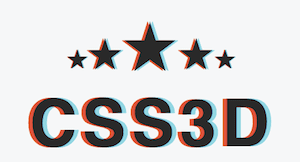
The stereoscopic 3D effect (see Anaglyph image for more) is an example of a simple line of code, put to great use. With the following line of CSS, we can create the illusion of depth when viewed with 3D red/cyan glasses (the kind they give you at 3D movies):
text-shadow: -0.06em 0 0 red, 0.06em 0 0 cyan;
There are two things to notice when converting this string to <canvas>:
- There is no shadow-blur (the third value), so there is no reason to actually run shadow, as fillText would create the same results:
var text = "Hello world!"
ctx.fillStyle = "#000"
ctx.fillText(text, -7, 0);
ctx.fillStyle = "red"
ctx.fillText(text, 0, 0);
ctx.fillStyle = "cyan"
ctx.fillText(text, 7, 0);</pre>
- EM 's aren 't supported in
<canvas>so they 'll have to be converted to PX 's. We can find the conversion ratio for converting between PT, PC, EM, EX, PX and so-forth by creating an element with the same font-properties in DOM, and setting the width to the format to be measured; or instance, to capture the EM -> PX conversion, we 'd measure the DOM element with a "height: 1em", the resulting offsetHeight would be how many PX 's are in each EM.
var font = "20px sans-serif"
var d = document.createElement("span");
d.style.cssText = "font: " + font + " height: 1em; display: block"
// the value to multiply PX 's by to convert to EM 's
var EM2PX = 1 / d.offsetHeight;</pre>
Preventing alpha-multiplication
In a more complex example, such as the Neon effect found on Line25, the
shadowBlur property must be used to emulate the effect properly. Since the
Neon effect relies on multiple shadows, we run into a problem; in <canvas>
each vector object can only have one shadow. So, in order to draw multiple
shadows, you must draw multiple versions of the text on top of itself.
This results in alpha multiplication, and ultimately jagged edges.
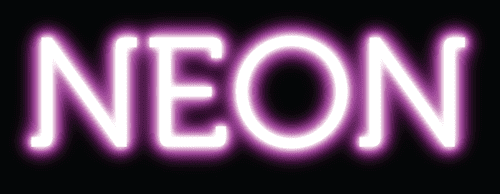
I tried running ctx.fillStyle = "rgba(0,0,0,0)" or "transparent"
to hide the text, while displaying the shadow… however, this attempt was futile;
since the shadow is a multiplication of the fillStyle alpha, the shadow can never
be more opaque than the fillStyle.
Luckily, there is a way around this, we can draw the shadow offset from the text, keeping them separated (so they 're not overlapping), and thereby hiding the text off the side of the screen:
var text = "Hello world!"
var blur = 10;
var width = ctx.measureText(text).width + blur * 2;
ctx.textBaseline = "top"
ctx.shadowColor = "#000"
ctx.shadowOffsetX = width;
ctx.shadowOffsetY = 0;
ctx.shadowBlur = blur;
ctx.fillText(text, -width, 0);
Clipping around a text block
To clean this up a bit we can prevent the fillText from being drawn in the
first place (while allowing the shadow to be drawn) by adding a clipping path.
In order to create a clipping path surrounding the text, we need to know the
height of the text (called the "em-height" historically the height
of the letter "M" on a printing press), and the width of the text.
We can get the width using ctx.measureText().width, however,
ctx.measureText().height doesn 't exist.
Luckily, through CSS hack-ardry (see Typographic Metrics
for more ways to fix older implementations of <canvas> using CSS measurements),
we can find the height of the text through measuring the offsetHeight of a <span>
with the same font-properties:
var d = document.createElement("span");
d.font = "20px arial"
d.textContent = "Hello world!"
var emHeight = d.offsetHeight;
From there, we can create a rectangle to use as a clipping path; enclosing the "shadow" while removing the dummy-shape.
ctx.rect(0, 0, width, emHeight);
ctx.clip();
Tying it all together, and optimizing as we go - if a shadow has no blur, fillText can be used to the same effect, saving us from setting up the clipping mask:
var width = ctx.measureText(text).width;
var style = shadowStyles[text];
// add a background to the current effect
ctx.fillStyle = style.background;
ctx.fillRect(0, offsetY, ctx.canvas.width, textHeight - 1)
// parse text-shadows from css
var shadows = parseShadow(style.shadow);
// loop through the shadow collection
var n = shadows.length; while(n--) {
var shadow = shadows[n];
var totalWidth = width + shadow.blur * 2;
ctx.save();
ctx.beginPath();
ctx.rect(offsetX - shadow.blur, offsetY, offsetX + totalWidth, textHeight);
ctx.clip();
if (shadow.blur) { // just run shadow (clip text)
ctx.shadowColor = shadow.color;
ctx.shadowOffsetX = shadow.x + totalWidth;
ctx.shadowOffsetY = shadow.y;
ctx.shadowBlur = shadow.blur;
ctx.fillText(text, -totalWidth + offsetX, offsetY + metrics.top);
} else { // just run pseudo-shadow
ctx.fillStyle = shadow.color;
ctx.fillText(text, offsetX + (shadow.x||0), offsetY - (shadow.y||0) + metrics.top);
}
ctx.restore();
}
// drawing the text in the foreground
if (style.color) {
ctx.fillStyle = style.color;
ctx.fillText(text, offsetX, offsetY + metrics.top);
}
// jump to next em-line
ctx.translate(0, textHeight);
Since you're not going to want to enter all these <canvas> commands
manually, I 've included a simple text-shadow parser in the demo source;
this way you can feed it CSS commands and have it generate <canvas> commands.
Now, our <canvas> elements have a whole range of styles it can tie into.
These same shadow-effects can be used on any vector object, from WebFonts to
complex shapes imported from SVGs, to generative vector shapes, and so on!

Intermission (tangent on pixel-pushing)
In writing this section of the article, the Stereoscopic example made me curious. How hard it would be to create a 3D-movie-screen effect using <canvas> and two images taken from slightly different perspectives? Apparently, not too hard. The following kernel combines the red channel of the first image (data) w/ the cyan channel of the second image (data2):
data[i] = data[i] * 255 / 0xFF;
data[i+1] = 255 * data2[i+1] / 0xFF;
data[i+2] = 255 * data2[i+2] / 0xFF;
Now, someone just needs to duct-tape two iPhones to their forehead, click "record video" at the same time, and we could make our own 3D movies in HTML5. Any volunteers?

Neon-rainbow, zebra-reflection—chaining effects
Chaining multiple effects in <canvas> can be simple, but a basic
knowledge of the globalCompositeOperation (GCO) is required. To compare the
operations to GIMP (or Photoshop): there are 12 GCO 's in <canvas>
darker, and lighter can be thought of as layer blend-modes;
the other 10 operations are applied to the layers as alpha masks (one layer
removes the pixels of the other layer). The globalCompositeOperation ties "layers"
(or in our case, strings of code) together, combining them in new and exciting ways:
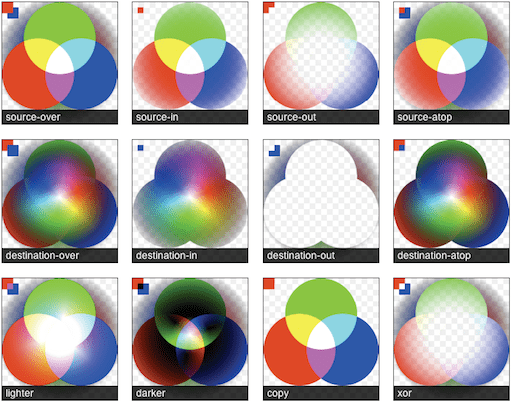
The globalCompositeOperation chart shows GCO modes at work; this chart uses a large portion of the color-spectrum and multiple levels of alpha transparency in order to see in detail what to expect. I would recommend checking out Mozilla 's globalCompositeOperation reference for textual descriptions. For further research, you can learn how the operation work in Porter Duff 's Compositing Digital Images.
My favorite mode is globalCompositeOperation="lighter". Lighter mixes
the appended pixels similar to how light mixes; when red, green and white light are at
full-intensity, we see white-light. It 's a exciting feature to play around
with, especially when the <canvas> is set to a low globalAlpha; enabling finer control,
and smoother edges. Lighter has been put to many uses, my recent favorite being a
HTML5 desktop background creator found at http://weavesilk.com/.
One of my demos, Breathing Galaxies (JS1k),
also uses the lighter mode - drawing patterns from these two examples you start to
see what effect this mode yields.
globalCompositeOperation browser handling.
Neon-Rainbow Jitter Effect
In the following demo, we 're going to achieve a Photoshop-like
neon-rainbow-glow with a jittered outline, by chaining effects together using the
globalCompositeOperation (source-in, lighter, and darker).
This demo is a progression of the "Text-Shadows in <canvas>" demo,
using the same strategy in separating the shadow from the text (see previous section):
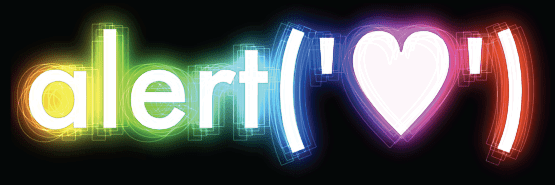
function neonLightEffect() {
var text = "alert('"+String.fromCharCode(0x2665)+"')";
var font = "120px Futura, Helvetica, sans-serif";
var jitter = 25; // the distance of the maximum jitter
var offsetX = 30;
var offsetY = 70;
var blur = getBlurValue(100);
// save state
ctx.save();
ctx.font = font;
// calculate width + height of text-block
var metrics = getMetrics(text, font);
// create clipping mask around text-effect
ctx.rect(offsetX - blur/2, offsetY - blur/2,
offsetX + metrics.width + blur, metrics.height + blur);
ctx.clip();
// create shadow-blur to mask rainbow onto (since shadowColor doesn't accept gradients)
ctx.save();
ctx.fillStyle = "#fff";
ctx.shadowColor = "rgba(0,0,0,1)";
ctx.shadowOffsetX = metrics.width + blur;
ctx.shadowOffsetY = 0;
ctx.shadowBlur = blur;
ctx.fillText(text, -metrics.width + offsetX - blur, offsetY + metrics.top);
ctx.restore();
// create the rainbow linear-gradient
var gradient = ctx.createLinearGradient(0, 0, metrics.width, 0);
gradient.addColorStop(0, "rgba(255, 0, 0, 1)");
gradient.addColorStop(0.15, "rgba(255, 255, 0, 1)");
gradient.addColorStop(0.3, "rgba(0, 255, 0, 1)");
gradient.addColorStop(0.5, "rgba(0, 255, 255, 1)");
gradient.addColorStop(0.65, "rgba(0, 0, 255, 1)");
gradient.addColorStop(0.8, "rgba(255, 0, 255, 1)");
gradient.addColorStop(1, "rgba(255, 0, 0, 1)");
// change composite so source is applied within the shadow-blur
ctx.globalCompositeOperation = "source-atop";
// apply gradient to shadow-blur
ctx.fillStyle = gradient;
ctx.fillRect(offsetX - jitter/2, offsetY,
metrics.width + offsetX, metrics.height + offsetY);
// change composite to mix as light
ctx.globalCompositeOperation = "lighter";
// multiply the layer
ctx.globalAlpha = 0.7
ctx.drawImage(ctx.canvas, 0, 0);
ctx.drawImage(ctx.canvas, 0, 0);
ctx.globalAlpha = 1
// draw white-text ontop of glow
ctx.fillStyle = "rgba(255,255,255,0.95)";
ctx.fillText(text, offsetX, offsetY + metrics.top);
// created jittered stroke
ctx.lineWidth = 0.80;
ctx.strokeStyle = "rgba(255,255,255,0.25)";
var i = 10; while(i--) {
var left = jitter / 2 - Math.random() * jitter;
var top = jitter / 2 - Math.random() * jitter;
ctx.strokeText(text, left + offsetX, top + offsetY + metrics.top);
}
ctx.strokeStyle = "rgba(0,0,0,0.20)";
ctx.strokeText(text, offsetX, offsetY + metrics.top);
ctx.restore();
};
Zebra Reflection Effect
The Zebra Reflection effect was inspired by WebDesignerWall 's excellent resource on how to spice up your page with CSS. This takes the idea a little bit further, creating a "reflection" for the text - such as what you might see in iTunes. The effect combines the fillColor (white), createPattern (zebra.png), and linearGradient (shine); this illustrates the ability to apply multiple fill types to each vector object:

function sleekZebraEffect() {
// inspired by - http://www.webdesignerwall.com/demo/css-gradient-text/
var text = "Sleek Zebra...";
var font = "100px Futura, Helvetica, sans-serif";
// save state
ctx.save();
ctx.font = font;
// getMetrics calculates:
// width + height of text-block
// top + middle + bottom baseline
var metrics = getMetrics(text, font);
var offsetRefectionY = -20;
var offsetY = 70;
var offsetX = 60;
// throwing a linear-gradient in to shine up the text
var gradient = ctx.createLinearGradient(0, offsetY, 0, metrics.height + offsetY);
gradient.addColorStop(0.1, '#000');
gradient.addColorStop(0.35, '#fff');
gradient.addColorStop(0.65, '#fff');
gradient.addColorStop(1.0, '#000');
ctx.fillStyle = gradient
ctx.fillText(text, offsetX, offsetY + metrics.top);
// draw reflected text
ctx.save();
ctx.globalCompositeOperation = "source-over";
ctx.translate(0, metrics.height + offsetRefectionY)
ctx.scale(1, -1);
ctx.font = font;
ctx.fillStyle = "#fff";
ctx.fillText(text, offsetX, -metrics.height - offsetY + metrics.top);
ctx.scale(1, -1);
// cut the gradient out of the reflected text
ctx.globalCompositeOperation = "destination-out";
var gradient = ctx.createLinearGradient(0, offsetY, 0, metrics.height + offsetY);
gradient.addColorStop(0.0, 'rgba(0,0,0,0.65)');
gradient.addColorStop(1.0, '#000');
ctx.fillStyle = gradient;
ctx.fillRect(offsetX, offsetY, metrics.width, metrics.height);
// restore back to original transform state
ctx.restore();
// using source-atop to allow the transparent .png to show through to the gradient
ctx.globalCompositeOperation = "source-atop";
// creating pattern from <image> sourced.
ctx.fillStyle = ctx.createPattern(image, 'repeat');
// fill the height of two em-boxes, to encompass both normal and reflected state
ctx.fillRect(offsetX, offsetY, metrics.width, metrics.height * 2);
ctx.restore();
};
Inner/outer shadows in Canvas
The <canvas> specs doesn 't touch on the subject of "inner"
vs. "outer" shadows. In fact, at first appearance, you may expect
"inner" shadow isn 't supported. This is not the case.
It 's just a bit tricker to enable ;) As proposed in a recent post
from F1LT3R,
you can create inner-shadows using the unique properties of clockwise vs. anti-clockwise
winding rules. To do this, you create an "inner-shadow" by drawing container
rectangle, and then, using opposite winding rules, draw a cutout shape - creating
the inverse of the shape.
The following example allows for the inner-shadow and fillStyle to be stylized with color+gradient+pattern simultaneously. You can specify pattern rotation individually; notice the zebra stripes are now perpendicular to each-other. A clipping mask the size of the bounding-box is used removing the need for a super-large container to enclose the cutout shape - improving the speed by preventing the unnecessary parts of the shadow from being processed.
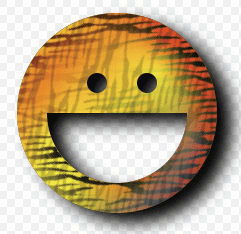
function innerShadow() {
function drawShape() { // draw anti-clockwise
ctx.arc(0, 0, 100, 0, Math.PI * 2, true); // Outer circle
ctx.moveTo(70, 0);
ctx.arc(0, 0, 70, 0, Math.PI, false); // Mouth
ctx.moveTo(-20, -20);
ctx.arc(30, -30, 10, 0, Math.PI * 2, false); // Left eye
ctx.moveTo(140, 70);
ctx.arc(-20, -30, 10, 0, Math.PI * 2, false); // Right eye
};
var width = 200;
var offset = width + 50;
var innerColor = "rgba(0,0,0,1)";
var outerColor = "rgba(0,0,0,1)";
ctx.translate(150, 170);
// apply inner-shadow
ctx.save();
ctx.fillStyle = "#000";
ctx.shadowColor = innerColor;
ctx.shadowBlur = getBlurValue(120);
ctx.shadowOffsetX = -15;
ctx.shadowOffsetY = 15;
// create clipping path (around blur + shape, preventing outer-rect blurring)
ctx.beginPath();
ctx.rect(-offset/2, -offset/2, offset, offset);
ctx.clip();
// apply inner-shadow (w/ clockwise vs. anti-clockwise cutout)
ctx.beginPath();
ctx.rect(-offset/2, -offset/2, offset, offset);
drawShape();
ctx.fill();
ctx.restore();
// cutout temporary rectangle used to create inner-shadow
ctx.globalCompositeOperation = "destination-out";
ctx.fill();
// prepare vector paths
ctx.beginPath();
drawShape();
// apply fill-gradient to inner-shadow
ctx.save();
ctx.globalCompositeOperation = "source-in";
var gradient = ctx.createLinearGradient(-offset/2, 0, offset/2, 0);
gradient.addColorStop(0.3, '#ff0');
gradient.addColorStop(0.7, '#f00');
ctx.fillStyle = gradient;
ctx.fill();
// apply fill-pattern to inner-shadow
ctx.globalCompositeOperation = "source-atop";
ctx.globalAlpha = 1;
ctx.rotate(0.9);
ctx.fillStyle = ctx.createPattern(image, 'repeat');
ctx.fill();
ctx.restore();
// apply fill-gradient
ctx.save();
ctx.globalCompositeOperation = "destination-over";
var gradient = ctx.createLinearGradient(-offset/2, -offset/2, offset/2, offset/2);
gradient.addColorStop(0.1, '#f00');
gradient.addColorStop(0.5, 'rgba(255,255,0,1)');
gradient.addColorStop(1.0, '#00f');
ctx.fillStyle = gradient
ctx.fill();
// apply fill-pattern
ctx.globalCompositeOperation = "source-atop";
ctx.globalAlpha = 0.2;
ctx.rotate(-0.4);
ctx.fillStyle = ctx.createPattern(image, 'repeat');
ctx.fill();
ctx.restore();
// apply outer-shadow (color-only without temporary layer)
ctx.globalCompositeOperation = "destination-over";
ctx.shadowColor = outerColor;
ctx.shadowBlur = 40;
ctx.shadowOffsetX = 15;
ctx.shadowOffsetY = 10;
ctx.fillStyle = "#fff";
ctx.fill();
};
From these examples you can see, using globalCompositeOperation, we can chain-effects together, producing more elaborate effects (utilizing masking and blending). The screen is your oyster ;)
Spaceage—generative effects
In <canvas>, going from the unicode character 0x2708:
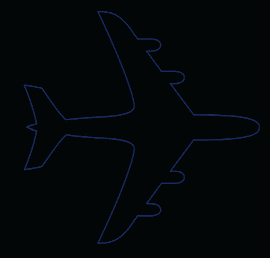
…to this shaded example:

…can be achieved by multiple calls to ctx.strokeText() with a thin lineWidth (0.25),
while slowly decreasing the x-offset and alpha; giving our vector elements the feeling of motion.
By mapping the elements XY position to a sine/cosine wave, and cycling through colors using the HSL property, we can create more interesting effects, such as this "biohazard" example:

HSL: Hue, Saturation, Lightness (1978)
HSL is a newly supported format in the CSS3 specs. Where HEX was designed for computers, HSL is designed to be human readable.
Illustrating the ease of HSL; to cycle through the color-spectrum, we 'd simply increment the "hue" from 360; the hue is mapped to the spectrum in cylindric fashion. Lightness controls how how dark/light the color is; 0% indicates a black pixel, whereas 100% indicates a white pixel. Saturation controls how bright or vivid a color is; grey 's are created with a saturation of 0%, and vivid colors are created using a value of 100%.
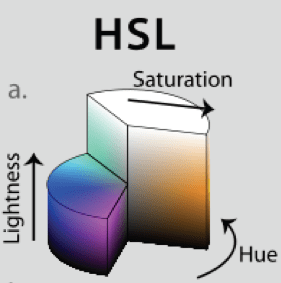
Since HSL is a recent standard, you may wish to continue supporting older browsers, which is possible via color-space conversion. The following code accepts an HSL object { H: 360, S: 100, L: 100} and outputs a RGB object { R: 255, G: 255, B: 255 }. From there, you can use those values to create your rgb or rgba string. For more in depth information see Wikipedia 's insightful article on HSL.
// HSL (1978) = H: Hue / S: Saturation / L: Lightness
HSL_RGB = function (o) { // { H: 0-360, S: 0-100, L: 0-100 }
var H = o.H / 360,
S = o.S / 100,
L = o.L / 100,
R, G, B, _1, _2;
function Hue_2_RGB(v1, v2, vH) {
if (vH < 0) vH += 1;
if (vH > 1) vH -= 1;
if ((6 * vH) < 1) return v1 + (v2 - v1) * 6 * vH;
if ((2 * vH) < 1) return v2;
if ((3 * vH) < 2) return v1 + (v2 - v1) * ((2 / 3) - vH) * 6;
return v1;
}
if (S == 0) { // HSL from 0 to 1
R = L * 255;
G = L * 255;
B = L * 255;
} else {
if (L < 0.5) {
_2 = L * (1 + S);
} else {
_2 = (L + S) - (S * L);
}
_1 = 2 * L - _2;
R = 255 * Hue_2_RGB(_1, _2, H + (1 / 3));
G = 255 * Hue_2_RGB(_1, _2, H);
B = 255 * Hue_2_RGB(_1, _2, H - (1 / 3));
}
return {
R: R,
G: G,
B: B
};
};
Creating animations with requestAnimationFrame
In the past, to create animations in Javascript, there was two choices; setTimeout,
and setInterval.
window.requestAnimationFrame, is the new standard here to replace
both; saving the world electricity (and your computer a few heartbeats) by
allowing the browser to regulate animations based on available resources.
Some important features include:
- When a user exists the frame, the animation can slow down or stop completely, to prevent the use of unneeded resources.
- There is a limit cap to the frame-rate at 60FPS. The reason for this is it 's well above the level humans can notice (most humans by 30FPS see animation being "fluid").
At the time of writing, vender specific prefixes are required to use requestAnimationFrame.
Paul Irish created a shim layer that has cross-vender support, in requestAnimationFrame for
smart animating:
// shim layer with setTimeout fallback
window.requestAnimFrame = (function(){
return window.requestAnimationFrame ||
window.webkitRequestAnimationFrame ||
window.mozRequestAnimationFrame ||
window.oRequestAnimationFrame ||
window.msRequestAnimationFrame ||
function(/* function */ callback, /* DOMElement */ element){
window.setTimeout(callback, 1000 / 60);
};
})();
Taking that a bit further, the more ambitious might tie this together with a poly-fill such as requestAnimationFrame.js (there are a few features to be worked out) that would support older browsers to a further extent, while switching to this new standard.
(function animate() {
var i = 50;
while(i--) {
if (n > endpos) return;
n += definition;
ctx.globalAlpha = (0.5 - (n + startpos) / endpos) * alpha;
if (doColorCycle) {
hue = n + color;
ctx.strokeStyle = "hsl(" + (hue % 360) + ",99%,50%)"; // iterate hue
}
var x = cos(n / cosdiv) * n * cosmult; // cosine
var y = sin(n / sindiv) * n * sinmult; // sin
ctx.strokeText(text, x + xoffset, y + yoffset); // draw rainbow text
}
timeout = window.requestAnimationFrame(animate, 0);
})();
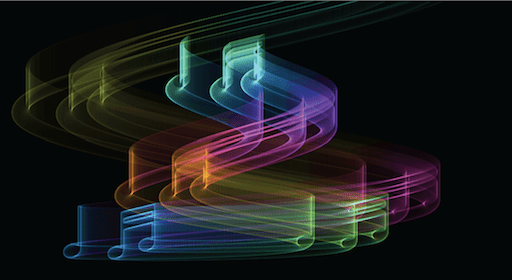
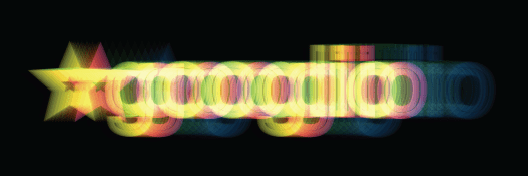

Source-code
With support from across browser vendor-sphere, there is no question about the
future of <canvas> it can be ported to the iPhone/Android/Desktop executables
using PhoneGap, or

